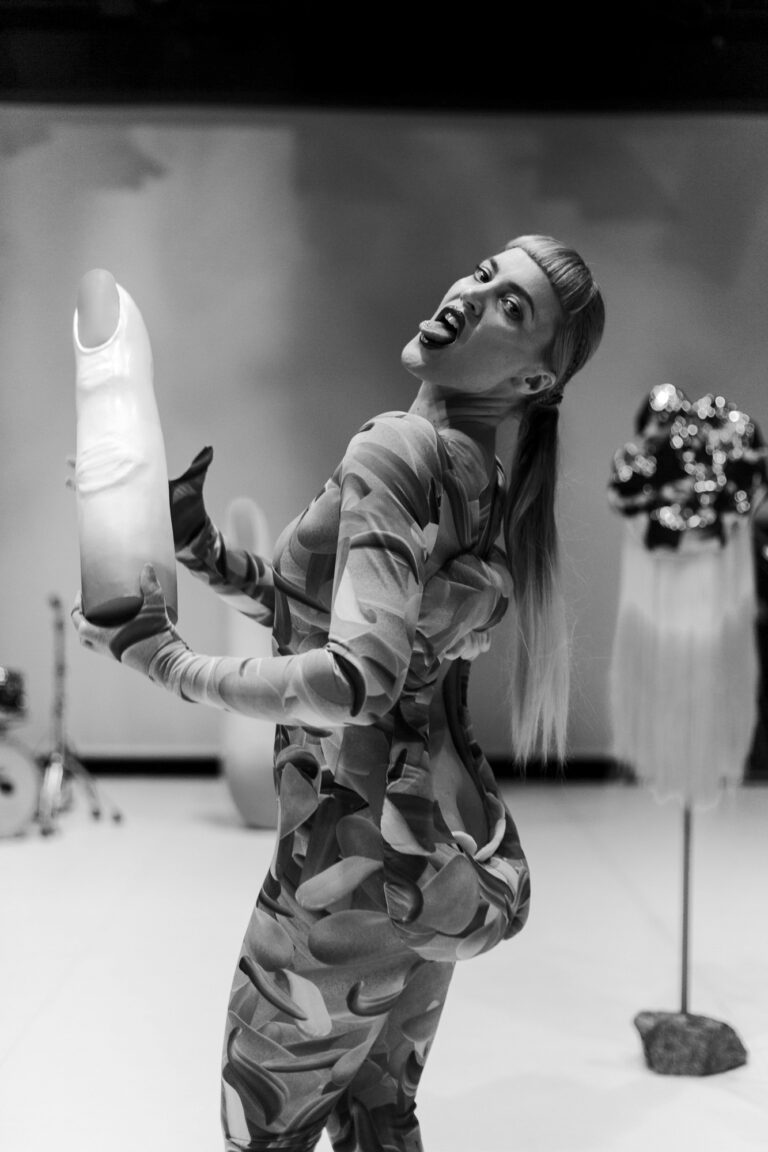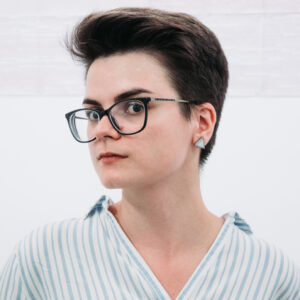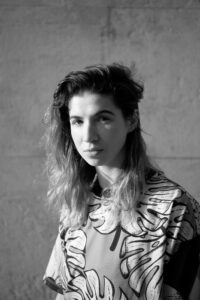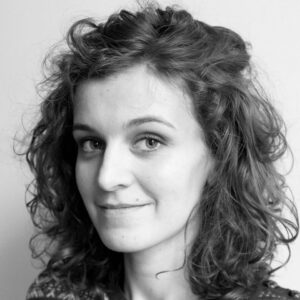Marta Ziółek

– born in 1986. Choreographer, director and performer living in Warsaw. Studied at School for New Dance Development (SNDO) in Amsterdam and at the Interdepartmental Individual Studies in Humanities at the University of Warsaw. In her work she focuses on exploring new forms of expression and embodiment; she uses the language of new technologies and pop culture; she is interested in new rituals and the performatics of identity. She constantly crosses boundaries between theatre, visual arts, performance, film and choreography, which she consistently tries to broaden.
No excess, no dance, no revolution!
Look at me
I will let you in
(…)
Today to the surface will rise ride
The curtain of lips is parted at last
Sweet contours cracking this opening fast
the membrane is loose
of mucus and cells
the skull loosened up
the crevice is cracked
bitchy-witchy
cavern cave
1
As a woman artist working by means of the body and dance, I combine my artistic action with the act of ‘speaking’ in public. Choreography is a way for me to vocalize and embody my position, my anxiety and my worries. The voice is my sounding, vibrating self. It stretches me and connects me to politics. My voice, my cry comes from the viscera, from the belly, it is mine and not mine. It has gender, it is class-situated, it is infected by the place from which it comes, it is between me and another whom it addresses, who hears it, in whom it resonates. It is of me and it is beyond me. I open my mouth. It is the drama of my body. The voice pierces, pours out and acts, it is a primordial bodily event. I shout, I call out, in my desire to be heard I wait for an answer. I speak, buzz, vibrate and thunder to be closer to another body. I open my mouth – a tunnel leading to the throat, to the larynx. I go beneath the surface, opening the inwardness, the pulsations of the heart, the vibration of the breath.
I am on the second day of protest, the Women’s Strike, against the Constitutional Tribunal’s ruling on the total ban on abortion in Poland. It is the year 2020, and I feel as if I have been transported back in time to 1968, as if a sexual revolution, the like of which has never been here before, were taking place in Poland. It is a revolution of women. I feel that only from this place can I speak today about the purposefulness and purposelessness of artistic work, about my voice, my body and the heart of my practice as an artist. What has hitherto been repressed, frozen, comes out, rises, ticks, splashes, explodes outwards. The best choreography happens on the street.
She wants freedom, the right to express herself, the right of all to be beautiful and stunning. I feel this voice of Grandma Emma Goldman speaking within me. Bread and dance! Excess! Today, as an artist, I begin my performance on the street. I am staging a self-birth. The witch is the one who gives birth to herself.
My body belongs to me. I share it and liquefy it, I open the borders and invite it in. My choreographic practice begins here, from this body, from open boundaries, fluids, infections – from the inside out. This statement is about the power of the shriek of the body’s innards, viscerality, the power of female physiology, fluid sexuality, eroticism slipping through the surveillance of power. When the state does not protect me, my sisters will.
For years women, instead of submitting to the erotic power of vocalisation, have been positioned as “the one without a voice”. In recent years, my artistic work has thrived in this strange political climate of repression of the female voice and the right to decide on one’s own body, starting with Black Protest in 2016 until now.
It is not the voice I hear, but the body. Someone who moves and desires. In my work I learn from the voice, who I am when it sounds me, when it emerges from my belly, pussy, throat, lips, face. The anatomy of muscles and emotions. Mouth movement, tongue position, modality, volume, timbre, breath, tone, the sensory quality of words, oral manifestation. Theatre of the mouth. Choreographies of voluminous intensity, sonority full of animation, expanding the scales of the body.
Dance is always a practice of contact, of relationship and of some kind of arrangement of forces. It is also an endless experimentation on the sensual. Always between figuration and flesh. When I dance, I feel myself transforming. Dance for me is an act of power, a sculpting of presence, an intensification of being, a force as such. My dance is not ashamed to be angry and it is visionary. My dance is a feeling, a greed for experience, an open circulation of change. It is a potential movement of resistance.
Recently I have created Monstera2, in which I deal with the corporeal enactment of the female subject, and whose matron is Medusa. As Helen Cixous writes, you only have to look at Medusa’s face to see it: you don’t die from it. She is beautiful and she laughs. In the performance, together with a group of female artists, I explore the living areas of female physiology – the cavern of the body, its voice and sexuality in relation to power and the right to self-determination. I look at the female corporeality not as something fixed and essential, but as an open spilling over structure, breathing, vibrating, wheezing, barking, catching breath, sucking, releasing cry, being in a constant dialogue of emotional and physiological reprocessing.
With an awareness of the emotional anatomy and sexuality of the body, I believe we can take power over what takes it from us. We can be witches and have the courage to give birth to ourselves. To have the courage to scream and release. To follow the truth of inner guidance and feeling from within our own bodies.
The text was written in collaboration with Agnieszka Sosnowska (2020).
1Marta Ziółek, Monstera, 2020, play, script: Anka Herbut.2See: https://www.teatrstudio.pl/pl/spektakl/monstera
– urodzona w 1986. Choreografka, reżyserka i performerka mieszkająca w Warszawie. Studiowała w School for New Dance Development (SNDO) w Amsterdamie oraz na Międzywydziałowych Indywidualnych Studiach Humanistycznych na Uniwersytecie Warszawskim. W swojej pracy skupia się na badaniu nowych form ekspresji i ucieleśnień; operuje językiem nowych technologii i popkultury; interesują ją nowe rytuały i performatyka tożsamości. Stale przekracza granice między teatrem, sztukami wizualnymi, performansem, filmem i choreografią, której obszar konsekwentnie stara się poszerzać.
Bez nadmiaru, bez tańca nie będzie rewolucji!
Na mnie patrz
Wpuszczę cię
(…)
Kurtyna ust ma pełne rozwarcie
Pęka słodki kontur i robi to otwarcie
Luzuje się błona
Śluzowo-komórkowa
Rozluźnia się czaszka
Rozkurcza szczelina
Suczko-samiczka
Jama jaskinia
1
Jako kobieta-artystka działająca poprzez ciało i taniec, łączę moje działanie artystyczne z aktem „mówienia” publicznie. Choreografia jest dla mnie sposobem na wokalizację i ucieleśnienie mojego stanowiska, niepokoju i mojej troski. Głos jest moim dźwięczącym, wibrującym „ja”. Rozciąga mnie i wiążę z polityką. Mój głos, mój krzyk wypływa z trzewi, z brzucha, jest mój i nie-mój. Ma płeć, jest klasowo usytuowany, jest zainfekowany miejscem, z którego pochodzi, jest pomiędzy mną, a innym, którego adresuje, który go słyszy, w którym rezonuje. Jest ze mnie i jest poza mną. Otwieram usta. To drama mojego ciała. Głos przebija się, wylatuje i działa, jest prymarnym wydarzeniem cielesnym. Krzyczę, nawołuję, w pragnieniu bycia usłyszaną czekam na odpowiedź. Mówię, brzęczę, wibruję i grzmię, aby znaleźć się bliżej innego ciała. Otwieram usta – tunel prowadzący do gardła, do krtani. Wchodzę pod powierzchnię, otwieram wewnętrzności, pulsacje serca, drganie oddechu.
Jestem na drugim dniu protestu, na Strajku Kobiet, przeciwko wyrokowi Trybunału Konstytucyjnego w sprawie całkowitego zakazu aborcji w Polsce. Jest rok 2020, a mam poczucie jakbym przeniosła się w czasie do 1968, tak jakby w Polsce wydarzała się właśnie rewolucja seksualna, której nigdy tu jeszcze nie było. Jest to rewolucja kobiet. Czuję, że tylko z tego miejsca mogę dziś mówić o celowości i bezcelowości pracy artystycznej, o moim głosie, ciele i sercu mojej praktyki jako artystki. To, co dotąd stłumione, zamrożone, wypływa, wynurza się, tik-tak, bryzga, wybucha na zewnątrz. Najlepsza choreografia wydarza się właśnie na ulicy.
Chce wolności, prawa do wyrażania siebie, prawa wszystkich do tego, co piękne i olśniewające. Czuję, jak ten głos babci Emmy Goldman przemawia we mnie. Chleba i tańca! Nadmiaru! Dziś jako artystka zaczynam swój performans na ulicy. Inscenizuję samo-poród. Czarownica jest tą, która rodzi siebie.
Moje ciało należy do mnie. Dzielę się nim i je upłynniam, otwieram granice i zapraszam do środka. Moja praktyka choreograficzna zaczyna się tu, z tego ciała, z otwartych granic, płynów, infekcji – ze środka na zewnątrz. Ten statement jest o mocy wrzasku wnętrzności ciała, wisceralności, o sile kobiecych fizjologii, płynnej seksualności, erotyce wyślizgującej się nadzorowi władzy. Kiedy państwo mnie nie chroni, moje siostry będę bronić.
Przez lata kobiety, zamiast podporządkowywać się erotycznej sile wokalizacji, były ustawiane w pozycji „tej bez głosu”. W ostatnich latach moja praca artystyczna rozwijała się w tym dziwnym politycznym klimacie represji kobiecego głosu i prawa do decydowania o własnym ciele, poczynając od Czarnego Protestu w 2016 aż do dziś.
To nie głos słyszę, ale ciało. Kogoś, kto się porusza i pożąda. W mojej pracy uczę się od głosu, kim jestem, kiedy mną dźwięczy, kiedy wynurza się z mojego brzucha, cipki, gardła, warg, twarzy. Anatomia mięśni i emocji. Ruch ust, pozycja języka, modalność, głośność, tembr, oddech, ton, sensoryczna jakość słów, oralna manifestacja. Teatr ust. Choreografie objętościowej intensywności, dźwięczność pełna animacji, rozszerzająca skale ciała.
Taniec zawsze jest praktyką kontaktu, relacji i jakiegoś układu sił. Jest też niekończącym się eksperymentowaniem na tym, co zmysłowe. Zawsze między figuracją, a mięsem. Kiedy tańczę, czuję, że się przepoczwarzam. Taniec jest dla mnie aktem mocy, rzeźbieniem obecności, intensyfikacją bycia, siłą jako taką. Mój taniec nie wstydzi się złościć i jest wizyjny. Mój taniec jest czuciem, zachłannością doświadczenia, otwartym obiegiem zmiany. Jest potencjalnym ruchem oporu.
W ostatnim czasie stworzyłam Monsterę2, w której zajmuję się cielesną inscenizacją kobiecego podmiotu, a której matronką jest Meduza. Jak pisze Helen Cixous, wystarczy spojrzeć na twarz Meduzy, aby ją ujrzeć: od tego się nie umiera. Ona jest piękna i śmieje się. W spektaklu wraz z grupą artystek badam żywe obszary kobiecej fizjologii – jaskini ciała, jego głosu i seksualności w relacji do władzy i prawa do samostanowienia. Przyglądam się kobiecej cielesności nie jako czemuś ustalonemu i esencjalnemu, lecz jako otwartej rozlewającej się strukturze, oddychającej, wibrującej, sapiącej, wyszczekującej, łapiącej oddech, ssącej, uwalniającej płacz, będącej w ciągłym dialogu emocjonalnych i fizjologicznych przepoczwarzeń.
Mając świadomość emocjonalnej anatomii i seksualności ciała, wierzę, że możemy przejąć władzę nad tym, co nam ją odbiera. Możemy być wiedźmami i mieć odwagę rodzić siebie. Mieć odwagę na krzyk i uwolnienie. Podążać za prawdą wewnętrznego prowadzenia i czucia z wnętrza własnego ciała.
Tekst powstał we współpracy z Agnieszką Sosnowską (2020).
1Marta Ziółek, Monstera, 2020, spektakl, tekst: Anka Herbut.2Zob. https://www.teatrstudio.pl/pl/spektakl/monstera


